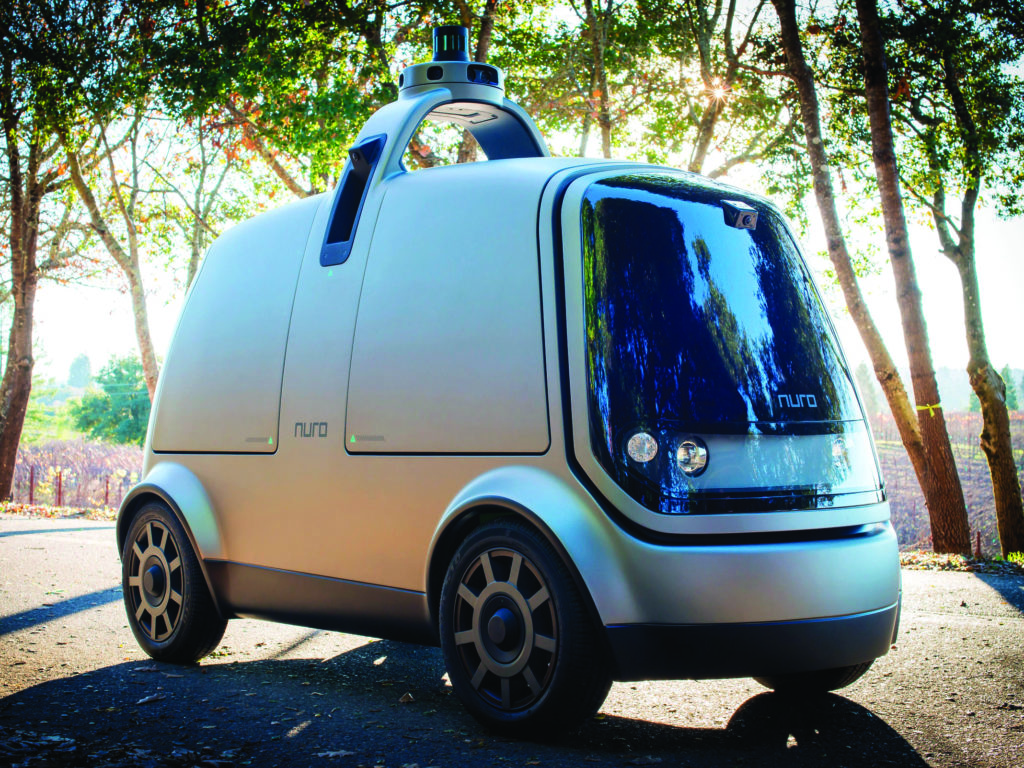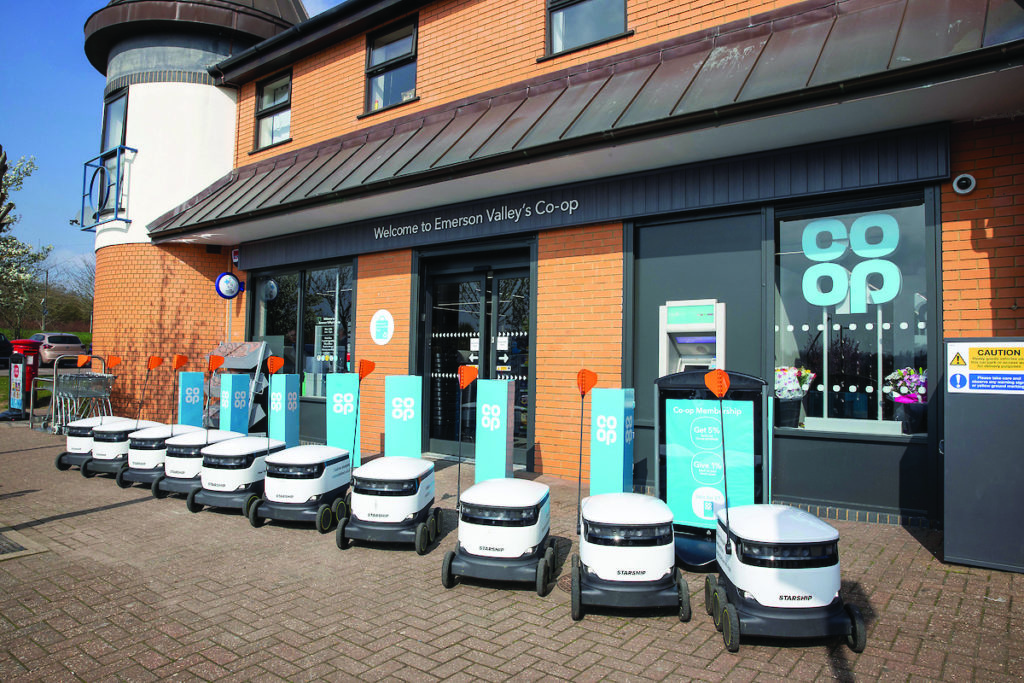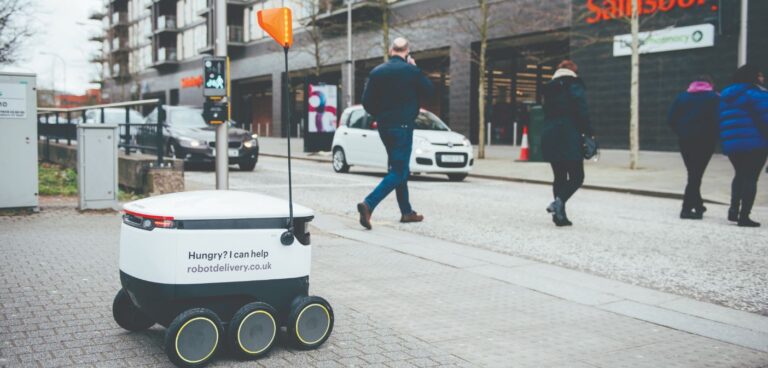Are autonomous delivery robots the ideal last-mile solution in a post-pandemic world? Alisdair Suttie reports…
The ‘new normal’ is a phrase we have all heard a lot of in the wake of the Covid-19 pandemic. Yet where there is great change, there is also opportunity and developers of self- driving delivery robots have been among those to seize their chance when the world went into lockdown.
There were several trials of autonomous last-mile delivery robots taking place around the world before the pandemic took hold, notably in several US cities, Toronto in Canada and and Milton Keynes in the UK.
These closely regulated tests found themselves under much greater scrutiny when the lockdown came into force as they offered a contact- free method of delivering goods to vulnerable people who were isolating, as well as those concerned about mixing in shops and public spaces. They have also proven very useful for delivering prescriptions from pharmacies to those in quarantine or isolating.
Andy Curtis, UK head of operations at Starship Technology, developer of a compact self-driving delivery robot, says: “Consumer behaviour was evolving to favour convenience even before coronavirus. We believe that autonomous delivery will become more popular going forward as people value their time more.”
Rebecca Yeung, vice president of advanced technology and innovation at FedEx, which has developed Roxo, an autonomous delivery device designed to travel on pavements and along roadsides, goes further: “There is certainly a lot of discussion about how autonomous robots and vehicles could be helpful within the global pandemic that we are currently experiencing.
“We believe that we will come out of this with a greater public understanding of the value of these devices and how they can benefit society moving forward, which could be helpful for our future testing endeavours.”
According to Yeung, FedEx is currently preparing for the next round of testing, having recently outfitted Roxo with new software and hardware components, in addition to a raft of pedestrian-safe technology, plus advanced systems such as lidar and multiple cameras, allowing the zero-emission battery-powered robot to be aware of its surroundings. These features are coupled with machine-learning algorithms to detect and avoid obstacles, plot a path, and allow the bot to follow road and safety rules.
“We learned a lot about Roxo during our first on-road tests with DEKA last year in three US cities [Memphis, Tennessee, Manchester, New Hampshire, and Frisco, Texas] and look forward to continued testing in 2020 once Covid-19 restrictions are lifted,” says Yeung.
Taking over the streets
Starship has already completed more than 100,000 deliveries using its small self-delivery robot, which is well suited to carrying takeaway meals and small top-up shops from grocery stores. In this time, the Starship robots have covered more than 500,000 miles and completed some five million road crossings, navigating through busy urban pavements and streets and carrying items within a four-mile radius of its base.

As with so many battery-powered vehicles, range is always a talking point, but Curtis says the Starship robot can work a 16-hour day before needing to be recharged. There are others offering a similar package to FedEx and Starship, such as Amazon Scout, KiwiBot, TeleRetail, Tiny Mile and Yandex. All provide a box on wheels that can keep food hot or cold, and they offer security by only opening for the customer using an app that also works when ordering a delivery.
However, these compact robots are limited in the amount they can deliver, which is where US robotics start-up Nuro has spotted an opportunity to bring the shop to the customer. Working in much the same way as ride-hailing apps like Uber, companies such as Nuro and Robomart have developed larger vehicles that give users a choice of goods on their doorstep. In essence, it’s the modern version of the old-fashioned mobile shop.
In both cases, the convenience to the customer is the big initial draw, but there are other reasons that shoppers are turning to them, as Curtis points out: “Autonomous delivery robots offer consumers a sustainable, convenient and affordable way of getting different items delivered.
“Deliveries arrive in under an hour on-demand and at low cost to the customer. These robots also take vehicles off the road as the customer doesn’t have to drive to the shop and nor is there a delivery van being used to drop off the order, which reduces both congestion and emissions.
“What’s more, they’re battery-powered, so customers can use Starship in the knowledge that they are not adding to their carbon footprint and the robot delivery can be tracked at all times by the customer, so they’re aware of where their delivery is.”

Safety measures
The tracking element is important to the customer and vital to the operator, so the robot knows where to deliver its load. As well as this, self-delivery robots are helping to push forward with autonomous vehicle technologies as they use a fusion of radar, lidar and proximity sensors to navigate around pedestrians, vehicles and other road users. FedEx’s Roxo robot has already notched up more than 10 million hours of real-world operation data.
As well as the sensors attached to self-delivery robots, the low speed of operation makes them safe and has helped win over public approval. Yeung adds: “We’ve worked very hard to think how Roxo can be safe and discuss how it fits in as part of society. This has been achieved through extensive testing, and conversations with customers, government and the public at large. The reception has been overwhelmingly positive.”
Dave Ferguson, co-founder and president of Nuro, believes there’s another factor helping endear self-driving delivery robots to the public: “Designing a vehicle from the ground up without the need for passengers or a driver, or any of the fittings of a car, means we can maximise load space and make the exterior simple and appealing. Also, we have put the safety of humans first, so Nuro can self-sacrifice in the event of a collision to protect lives.
“We believe self-driving delivery will help the development of autonomous vehicles as these machines can be scaled sooner and more affordably than self-driving passenger transportation.”
Fortunately, the regulatory hurdles that autonomous passenger vehicles have to overcome to conduct trials on public roads are far fewer for autonomous delivery robots. This has been proven by the expansion of Co-op’s robo-shopping service in Milton Keynes in the UK. Partly through consumer demand and also because of the Covid-19 outbreak, the company has extended its robot-delivery scheme to eight stores from the original two outlets in the Milton Keynes area.
Jason Perry, head of online development at Co-op, says: “Quality, ease and convenience is at the core of our approach and we’ll continue to innovate and expand access to our product lines to offer greater flexibility to consumers in our communities. We intend to offer the self-delivery option in 650 stores by the end of 2020.”
That pace of roll-out was already planned by Co-op, but the Covid-19 pandemic has confirmed the company’s belief in this technology. Along with others, it means autonomous delivery robots are set to become a much more common sight in towns and cities as part of the ‘new normal’.
Scout expansion
Amazon has announced the creation of a brand-new R&D team at its Cambridge development centre in the UK to work on the company’s electric autonomous delivery robots.Amazon Scout devices are the size of a small box and are designed roll along pavements at a walking pace. The service is in field test mode, currently delivering packages to customers in four states in the USA, with the project set to expand.
According to Amazon, the Cambridge team will consist of dozens of software development engineers.
“The team we’re building in Cambridge will work closely with the Amazon Scout research lab in Seattle to develop on-system software to help Scout delivery devices safely and autonomously navigate around pedestrians, pets, and obstacles found in residential neighbourhoods such as recycling bins and sign posts,” says Sean Scott, vice president of Amazon Scout.
The creation of the Amazon Scout team in Cambridge follows an announcement from Amazon earlier this year that it will create 10,000 new permanent roles across the UK in 2020, taking the company’s total permanent UK workforce to more than 40,000.
This article originally appeared in the November 2020 issue of CiTTi Magazine





